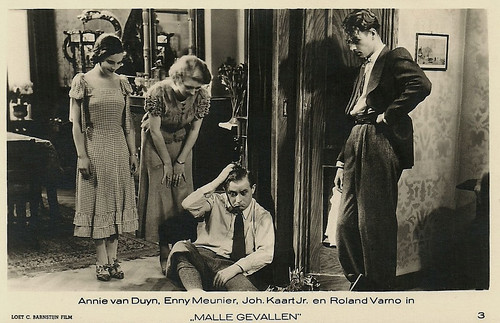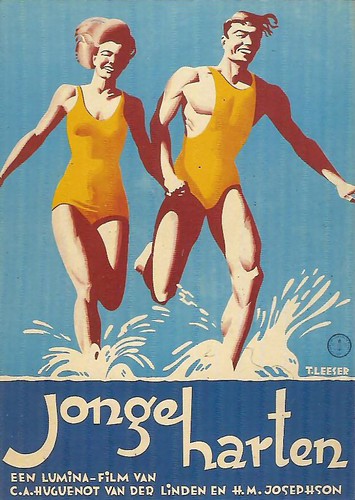
Dutch postcard by M. B.& Z. (M. Bonnist & Zonen, Amsterdam), no. 12. Photo: Loet C. Barnstijn Film. Publicity still for Malle gevallen/Silly Situations (Jaap Speyer, 1934).
Highly active
Louis de Bree was born Louis Christiaan Davids in Amsterdam in 1884. Louis' father was Izaak David Davids, and his mother was Anna Poolman. In order to avoid confusion with the popular vaudeville actor Louis Davids, who also performed in several Dutch films in the 1930s, he changed his name.
He started his stage career in 1907 - at the age of 23 - by the fortuitous circumstance that a player of the Amsterdam Toneel Gezelschap of Daan van Ollefen Sr. had fallen ill and he was allowed to fill in at the Paleis voor Volksvlijt. The result was that he left his job as a diamond cutter and became a professional actor.
He soon got known for his comic roles in theatre but also in Vaudeville and Operetta. For the latter section, he often collaborated with Annie Bakker, his wife as of 1922. In 1916, he was part of Nap de la Mar's operetta company and from 1921 to 1927 he was working as a theatre director.
The highly active De Bree was (co-)director for several comedy companies: 'De Kluchtspelers' (1916-1918), 'Het Vrolijk Tooneel' (1918-1919, 1924-1928, 1938-1939), 'Het Nederlandsch Vaudeville Gezelschap' (1920-1923), 'Het Centraal Tooneel' (1927-1933), and 'De Speeldoos' (1928-1929).
During the 1930s followed 'De Zomercombinatie Ruys - De Bree' (1932-1933), 'De Komedianten' (1936-1938), and 'Cabaret De Carroussel' (1937-1938). He also directed plays at 'Het Nederlandsch Tooneel', and other companies. De Bree was also a singer and composed some songs.

Dutch postcard. Photo: Loet C. Barnstijn Film. Louis de Bree in Malle gevallen/Silly Situations (Jaap Speyer, 1934).
Silly situations
In 1934, Louis de Bree's film career started with a part in the comedy Malle gevallen/Silly Situations (Jaap Speyer, 1934). The production was truly international. Dutch director Jaap Speyer had an extensive film career in Berlin. The script was written by German Hans Martin and was an adaptation of his novel. Music was by Ralph Erwin, creator of the famous song 'Ich küsse Ihre Hand, Madame'.
Sets were by the Viennese set designer Hans Ledersteger and cinematography was by Akos Farkas, a Hungarian Jew. While Erwin fell victim to the Nazis, Ledersteger pursued a career in Germany and Austria. Farkas married the daughter of... the producer of Malle gevallen: Loet Barnstijn. During the war, Farkas did not join his (Jewish) father-in-law in the US but went into hiding.
Louis de Bree became the leading actor of the comedy De kribbebijter/The Grumbler (Hermann Kosterlitz - the future Henry Koster, 1935). In this film, his regular co-actor and -director of the stage Cor Ruys plays a grumpy old baron who is only softened by his brother-in-law, played by De Bree. The film was based on the play 'Willis Frau' (Willy's Wife) by Reimann and Schwartz; De Bree wrote the dialogue himself.
Then followed the role of an inspector in Het mysterie van de Mondscheinsonate/The Mystery of the Mondschein Sonata (Kurt Gerron, 1935), a detective film based on a murder story by Willy Corsari.
De Bree also had a major part in De suikerfreule (Haro van Peski, 1935), a comedy set in the Dutch East Indies, and a small part in the romance Jonge harten/Young Hearts (Charles Huguenot van der Linden, Heinz Josephson, 1936). The latter film was remarkable for its location shooting while most Dutch films then were studio productions.

Dutch postcard, no. 1. Photo: Loet C. Barnstijn Film. Louis de Bree and Johan Kaart in Malle gevallen/Silly Situations (Jaap Speyer, 1934).

The other cast members of Malle gevallen/Silly Situations (1934). Dutch postcard by M. B.& Z. (M. Bonnist & Zonen, Amsterdam), no. 3. Photo: Loet C. Barnstijn Film.
Louis de Bree played in two Dutch versions of a multilingual, a much-tried phenomenon in the 1930s. Both films were shot at the Photo-Sonore-Studio in Paris. In Klokslag twaalf/At Twelve Sharp (Léo Joannon, 1936), the Dutch version of Quand minuit sonnera, De Bree plays the leading role of an industrial whose crime ten years before is about to expire, and his old gang wants to blackmail him. The cinematography was by Boris Kaufman and André Bac.
Shortly after, De Bree performed in a second film by Joannon, De man zonder hart/L'homme sans coeur/The Man Without a Heart (Léo Joannon, 1937), again based on a book by Alfred Marchard, and again with cinematography by Boris Kaufman. Here De Bree is an industrial who kills his partner when the other gives him (false) proof of his wife's infidelity. After 15 years of imprisonment, he plots to kill the daughter of his wife and her second husband.
For both films, De Bree wrote the dialogues, together with Sam Wagenaar. After that, he quit film acting, perhaps because of the unfavourable reception of the Léo Joannon films. However, he provided the voice. In 1938, he lent his voice to the Dutch versions of the Walt Disney animation films Snow White and the Seven Dwarfs (David Hand, a.o., 1937) and Alice in Wonderland (Clyde Geronimi, Wilfred Jackson, Hamilton Luske, 1951).
In 1949-1950, he ended his stage career after 40 years of stage tours. He became a member of the then Nederlandse Radio Unie (Netherlands Radio Union) and for 17 years, he would be the leading man in more than 1000 Dutch radio plays, until his death in 1971. Most notably, he was Sir Graham Forbes in the popular Paul Vlaanderen radio plays, adaptations of the BBC radio plays of Paul Temple by Francis Durbridge.
Louis de Bree passed away in Amersfoort, The Netherlands, in 1971. He was married twice. After Annie Bakker, Louis de Bree was married to actress Myra Ward (1941-1947).

Dutch film poster for De kribbebijter/The Grumbler (1935). Design: Frans Mettes.

Dutch film poster for Jonge harten/Young Hearts (1936). Design: Titus Leeser.
Sources: Kathinka Dittrich (Achter het doek. Duitse emigranten in de Nederlandse speelfilm in de jaren dertig - Dutch), Eye (Dutch), Hoorspelhelden in het kort (Dutch), Herman Van Cauwenberghe (Project Hilversum - Dutch), Wikipedia (Dutch), and IMDb.
This post was last updated on 7 August 2023.

Dutch postcard, no. 1. Photo: Loet C. Barnstijn Film. Louis de Bree and Johan Kaart in Malle gevallen/Silly Situations (Jaap Speyer, 1934).

The other cast members of Malle gevallen/Silly Situations (1934). Dutch postcard by M. B.& Z. (M. Bonnist & Zonen, Amsterdam), no. 3. Photo: Loet C. Barnstijn Film.
Multilingual
Louis de Bree played in two Dutch versions of a multilingual, a much-tried phenomenon in the 1930s. Both films were shot at the Photo-Sonore-Studio in Paris. In Klokslag twaalf/At Twelve Sharp (Léo Joannon, 1936), the Dutch version of Quand minuit sonnera, De Bree plays the leading role of an industrial whose crime ten years before is about to expire, and his old gang wants to blackmail him. The cinematography was by Boris Kaufman and André Bac.
Shortly after, De Bree performed in a second film by Joannon, De man zonder hart/L'homme sans coeur/The Man Without a Heart (Léo Joannon, 1937), again based on a book by Alfred Marchard, and again with cinematography by Boris Kaufman. Here De Bree is an industrial who kills his partner when the other gives him (false) proof of his wife's infidelity. After 15 years of imprisonment, he plots to kill the daughter of his wife and her second husband.
For both films, De Bree wrote the dialogues, together with Sam Wagenaar. After that, he quit film acting, perhaps because of the unfavourable reception of the Léo Joannon films. However, he provided the voice. In 1938, he lent his voice to the Dutch versions of the Walt Disney animation films Snow White and the Seven Dwarfs (David Hand, a.o., 1937) and Alice in Wonderland (Clyde Geronimi, Wilfred Jackson, Hamilton Luske, 1951).
In 1949-1950, he ended his stage career after 40 years of stage tours. He became a member of the then Nederlandse Radio Unie (Netherlands Radio Union) and for 17 years, he would be the leading man in more than 1000 Dutch radio plays, until his death in 1971. Most notably, he was Sir Graham Forbes in the popular Paul Vlaanderen radio plays, adaptations of the BBC radio plays of Paul Temple by Francis Durbridge.
Louis de Bree passed away in Amersfoort, The Netherlands, in 1971. He was married twice. After Annie Bakker, Louis de Bree was married to actress Myra Ward (1941-1947).

Dutch film poster for De kribbebijter/The Grumbler (1935). Design: Frans Mettes.

Dutch film poster for Jonge harten/Young Hearts (1936). Design: Titus Leeser.
Sources: Kathinka Dittrich (Achter het doek. Duitse emigranten in de Nederlandse speelfilm in de jaren dertig - Dutch), Eye (Dutch), Hoorspelhelden in het kort (Dutch), Herman Van Cauwenberghe (Project Hilversum - Dutch), Wikipedia (Dutch), and IMDb.
This post was last updated on 7 August 2023.
No comments:
Post a Comment